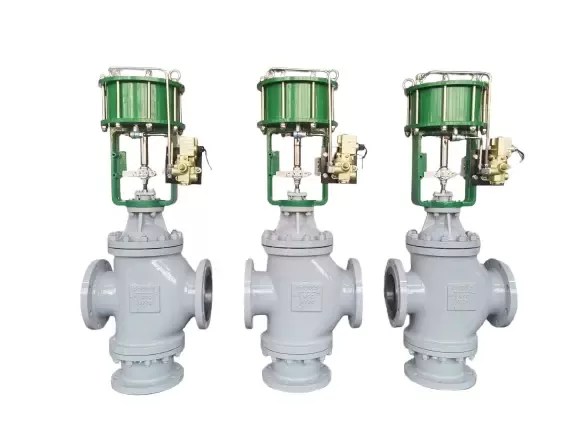Notifications

8 minutes, 30 seconds
-29 Views 0 Comments 0 Likes 0 Reviews

Pneumatic three-way control valves are vital components in industrial systems, designed to regulate the flow of various fluids, including water, steam, and gas. These heavy-duty valves are primarily used in diverting or mixing services, making them a versatile choice for a wide array of applications. Commonly found in heat control systems, such as those in heat exchangers, these China Control Valves are known for their precision, durability, and reliability under demanding conditions.
Typically powered by a multi-spring diaphragm actuator, pneumatic three-way control valves offer a simplified operating mechanism while delivering robust performance, even under high differential pressure. Whether employed for diverting or combining flows, these valves are a go-to solution in industries that demand accurate flow control.
Hysteresis Error:
Without positioner: ≤ 3% F.S.
With positioner: ≤ 1% F.S.
Linearity:
Without positioner: ≤ ±5% F.S.
With positioner: ≤ ±1% F.S.
These specifications highlight the valve’s capacity to maintain consistency and accuracy, especially when paired with a positioner.
Pneumatic three-way control valves operate using compressed air to actuate the valve mechanism. The valve features three ports: one inlet and two outlets (or vice versa). Powered by the pneumatic actuator, the valve's internal components move to either divert flow from one outlet to another or combine flows from two inlets into one outlet.
The multi-spring diaphragm motor, integral to the valve, converts the pneumatic signal into mechanical motion, allowing precise control over the valve’s position. This design ensures smooth operation, even in high-pressure conditions, making the valve suitable for demanding industrial environments.
In applications like heat exchangers, the valve controls the flow of heating or cooling media to maintain optimal temperatures. For example, in a diverting application, it can direct hot water to a heating system or bypass it to a cooling system, depending on the system's needs.
These valves are adaptable to a wide range of applications, handling both diverting and combining services. They are ideal for water, steam, and gas systems.
Offering hysteresis error as low as 1% F.S. and linearity within ±1% F.S. (when used with a positioner), these valves provide exceptional flow control.
Built to withstand high differential pressures and challenging operating conditions, pneumatic three-way control valves are designed for heavy-duty use.
The diaphragm motor is compact and lightweight, simplifying installation and maintenance.
These valves optimize flow control, helping reduce energy consumption in systems like HVAC, contributing to energy savings.
The valve’s simplified mechanism reduces wear and tear, minimizing the frequency of maintenance.
To ensure peak performance and longevity, proper maintenance of pneumatic three-way control valves is crucial. Here are some essential maintenance practices:
Regular Inspection: Routinely inspect the valve for any signs of wear, corrosion, or damage. Pay attention to the diaphragm, seals, and actuator.
Lubrication: Keep moving parts properly lubricated to reduce friction and prevent premature wear.
Cleaning: Remove any debris or buildup that could obstruct valve operation, especially in systems handling water or steam where mineral deposits may accumulate.
Calibration: Regularly calibrate the valve and positioner to ensure continued accuracy and performance.
Leak Detection: Check for any air or fluid leaks in the pneumatic system or valve body. Promptly address leaks to maintain system efficiency.
Replacement of Worn Parts: Replace worn or damaged components, such as seals and diaphragms, to keep the valve running smoothly.
By following these practices, you can extend the life of your pneumatic three-way control valve and minimize costly downtime.
Choosing between a two-way and a three-way control valve depends on the specific needs of your application. Here’s a comparison to help guide your decision:
Function: With one inlet and one outlet, two-way valves are used to start, stop, or regulate flow in one direction.
Applications: Best suited for simple flow regulation or on/off control where mixing or diverting isn’t required.
Advantages: Simpler design, lower cost, and easier installation.
Limitations: Limited to controlling flow in one direction; not suitable for applications requiring flow diversion or mixing.
Function: Featuring one inlet and two outlets (or vice versa), three-way valves are designed to divert, mix, or regulate flow between multiple streams.
Applications: Ideal for systems requiring precise temperature control, such as heat exchangers, or for diverting flow between processes.
Advantages: Greater versatility, ability to handle more complex flow control tasks, and improved energy efficiency in certain applications.
Limitations: More complex design, higher cost, and potentially more maintenance.
If your application only involves simple flow regulation or on/off control, a two-way valve will likely suffice. However, for systems requiring mixing, diverting, or precise temperature control, a three-way valve is the better option.
These valves find widespread use in numerous industries, thanks to their versatility and reliable performance. Common applications include:
HVAC Systems: Used to regulate the flow of heating or cooling media for precise temperature control and energy efficiency.
Heat Exchangers: Controls the flow of hot or cold fluids to maintain the desired temperature.
Industrial Processes: Used in manufacturing to divert or mix fluids, ensuring precise control of production parameters.
Water Treatment: Regulates the flow of water and chemicals in treatment plants, ensuring efficient processes.
Steam Systems: Controls steam flow for heating or power generation.
Pneumatic three-way control valves are indispensable in modern industrial systems, offering precise flow control, versatility, and durability. Whether in HVAC systems, heat exchangers, or other critical industrial processes, these valves provide dependable performance even under challenging conditions.
By understanding their operation, benefits, and maintenance requirements, you can ensure the valves perform optimally and last longer. Additionally, knowing the differences between two-way and three-way valves will help you make an informed choice for your specific application.
Investing in high-quality pneumatic three-way control valves ensures energy efficiency and reliable flow control for industries demanding precision and durability.Know more about Google SEO Directory

